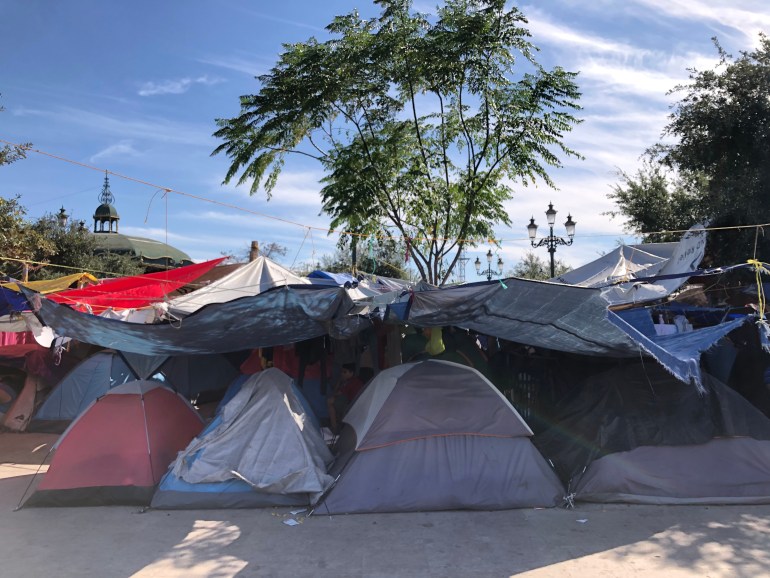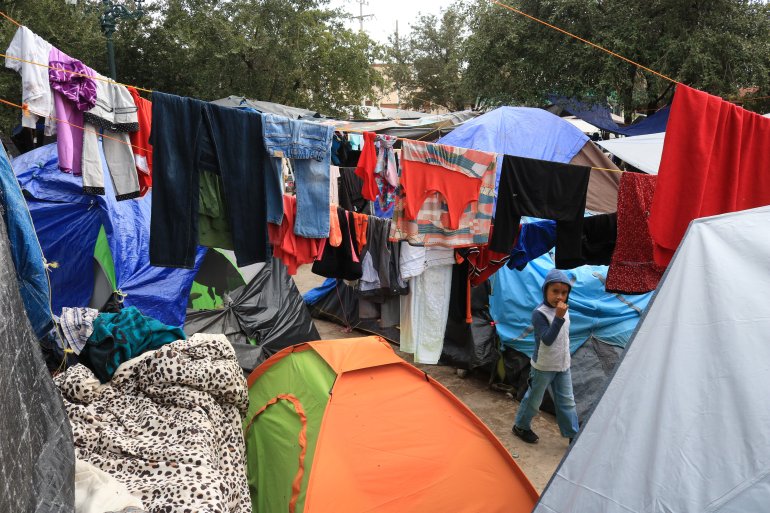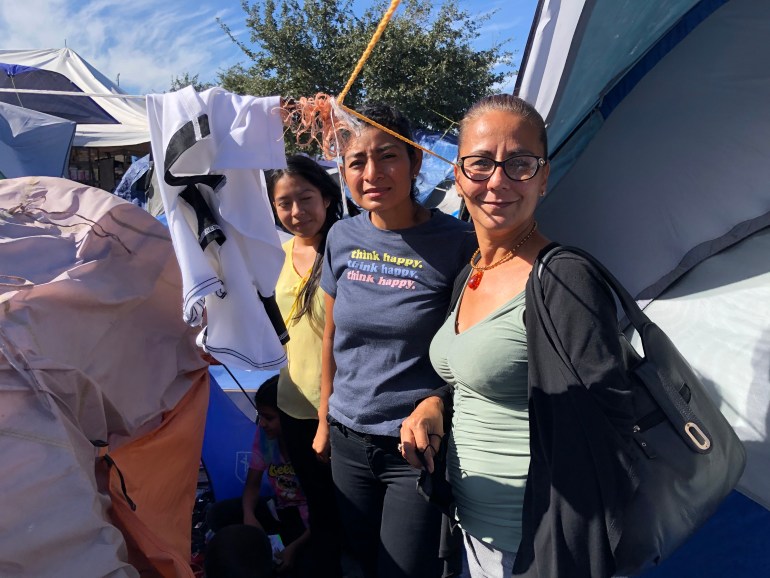In Mexico border camps, families ‘wait for US doors to open’
Asylum seekers blocked from seeking protection in the US say conditions in Mexican border areas are increasingly dire.

Reynosa, Mexico – When *Albert, 36, and his 10-year-old son reached the United States border last week, they hoped their month-long journey with smugglers from Honduras would end in a happy reunion with cousins in Florida ready to welcome them.
But after crossing the Rio Grande River into Texas, US border patrol agents picked up Albert and his son, drove them to the bridge to Mexico, and escorted them across.
Keep reading
list of 3 itemsUS, Canada, Mexico leaders to meet in first summit since 2016
Mexico’s AMLO does U-turn on central bank job
“I lost everything on the journey here, I have nowhere to go,” said Albert, who asked Al Jazeera not to use his real name due to fears he could be identified by kidnappers who prey on people along the US-Mexico border.
Once in the Mexican border city of Reynosa — home to nearly one million people — Albert saw a plaza crowded with tents. Hundreds of families are camped out here, stranded by the closure of the US border to asylum seekers since the onset of the COVID-19 pandemic.
“They gave me a tent to sleep in,” he said, standing in the muddy encampment. “Last night everything got wet and I began to cry.”
‘No place here’
Across Reynosa, crowds of mostly Central American or Haitian citizens live in camps, shelters or tenement houses, waiting for the expiration of coronavirus-related curbs that allow the US to turn back most asylum seekers at its southern border with Mexico.
The buildup has created a humanitarian problem over the last six months — the Reynosa camp began forming around June — while the flow of people has not stopped.
The number of arrivals at the southern US border is at a level unseen since the early 2000s, said Adam Isacson, who monitors the border at the research and advocacy group, the Washington Office on Latin America.
The surge has been driven in large part by people fleeing countries in Central America and Haiti amid myriad crises, Isacson told Al Jazeera, while others also are coming from South America. Economic crises that worsened due to COVID-19 and the loosening of pandemic-related travel restrictions have spurred migration in recent months, too.
But pandemic-related restrictions blocking most US asylum requests remain — and Mexican border cities are filling up.

“There is no place here for all these people to go,” said Felicia Rangel, volunteer co-director of the Sidewalk School for Children Asylum Seekers, an organisation that has provided schooling to children at the Texas border since late 2019.
“Yet buses and vans continue to come every day,” Rangel told Al Jazeera in an interview in her office across the street from the Reynosa encampment.
Title 42
In 2019, then-President Donald Trump launched a programme known as the Migrant Protection Protocols (MPP), also known as “Remain in Mexico”.
The widely-denounced policy forced asylum seekers to wait in Mexico while their claims were processed in US courts. Tens of thousands were sent back to Mexico from the US, where they built a sprawling tent camp at the US border in Matamoros, Mexico, and faced daily threats of violence, rape and other rights abuses.
Trump last year also enacted what is known as Title 42, a policy that cited the potential spread of COVID-19 to bar most asylum seekers from entering the country.
While US President Joe Biden exempted children from Title 42 expulsions, he has left the policy in place for most single adults and families arriving at the border, saying it is necessary to stop the potential spread of the coronavirus.

But Gladis Molina, executive director of the Young Center for Immigrant Children’s Rights in Chicago, said Title 42 “really isn’t a health issue, it’s an immigration deterrent”. Molina, who visited the Reynosa camp in November, said: “It’s a way to keep migrants out.”
It also remains in place despite the general lifting of pandemic restrictions and the opening of the US border to tourist travel last month. Molina said the Biden administration has given no timeline for when it plans to end its use of Title 42.
“This policy has to end,” Molina told Al Jazeera. “It’s our number-one issue.”
‘Remain in Mexico’ restarting
But even if Title 42 is lifted, other Trump-era rules will continue to make reaching the US difficult.
On Thursday, Mexico announced it had reached a deal with Washington to resume MPP, the rule requiring asylum seekers to wait months in Mexico for their cases to be processed in the US. Although Biden tried to repeal the rule, a court in Texas ordered its reinstatement in August.
The US Department of Homeland Security has said the programme will start up again on December 6, with removals to Mexico occurring at seven border crossings from California, Arizona and Texas, once MPP is fully functional again.
That means the problems driving the dire conditions on the border will likely continue.
At the plaza in Reynosa, residents of the encampment say waiting is made harder due to threats of illness and organised crime, among other dangers.
One man said he had been held captive with his seven-year-old son for two months. He said hooded men beat him and sent videos of their attacks to his family to extract a $10,000 ransom from them. He and his son were freed after the men received the payment, he said.
“For two months we didn’t see the sun,” he said. “The truth is I don’t know how much more of this I can take.”
Threats of violence
The threat of violence has led many parents to send their children across the bridge unaccompanied because they are not subject to Title 42 when travelling alone. Once in the US, they are taken into the custody of US authorities and then the families hope they will be reunited with relatives already in the country.
One couple at the camp in Reynosa said their 15-year-old son was beaten by cartel members while their 17-year-old daughter was threatened with sexual assault. When men came and tried to drag the girl out of the family’s tent one night, the parents said they decided to send them across the border into the US to try to find their grandmother in Georgia.
“Our great hope is to be with them again,” the mother said, standing outside the tent where she still lives with her husband and the 9-year-old son they kept behind.
Thousands of children have been similarly sent out of the camp in recent months, according to activists who work in Reynosa. Meanwhile, local churches and volunteer organisations provide for the bulk of the residents’ humanitarian needs, including untreated medical conditions.

Lourdes Gonzalez, a longtime advocate for the poor of Reynosa, told Al Jazeera she walks through the camp in the plaza looking for sick people every day. As she dodged tangled laundry lines and tarps on a recent day, people crowded around her to ask questions.
“This happens every time we come. All the sick people start coming,” said Gonzalez, a member of Angry Tias and Abuelas (Angry Aunts and Grandmothers), an activist association that aids people stranded in the Rio Grande Valley.
As Gonzales stood in a clearing amid the clustered tents, a pregnant woman said she needed medications; an elderly woman complained she had no pills to control her blood sugar; a young girl said she had a hernia; and a mother said her young son was raped.
Hope remains
Suyapa Rosa, a 36-year-old doctor, was with Gonzalez as she toured the camp. Rosa once worked in a hospital in San Pedro Sula, Honduras, but fled under threat of violence from gang members who she said threatened to kill her if she did not leave.
She crossed the Rio Grande with a large group and was bussed back to Reynosa by US border agents in September. She spent two weeks at the camp before going to live and work at a nearby clinic and shelter run by the Angry Tias and Abuelas group.
“It’s a very bad situation here,” she said as she took notes on the medical conditions of people in the camp.
But despite the hardships people face in the Reynosa camp, many are holding onto the hope of one day finding protection in the US.
“I feel destroyed, like my life has taken some horrible turn,” said a 40-year-old former school teacher, who also did not give Al Jazeera her name. She said she crossed the Rio Grande River into the US last month with her 14-year-old daughter, but they were sent back to Mexico.
“We are waiting for the doors of the US to open,” she said. “Miracles happen.”